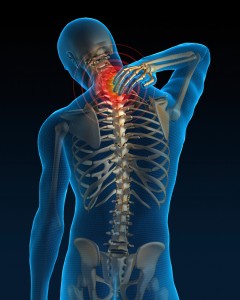Chiropractic Home Threapy for Neck Pain
As a St George chiropractor specializing in neck pain and trauma, I hear the following question a lot “is there anything I can do at home about my neck pain?” The answer is a resounding “yes.” In fact, home therapy is an integral part of any treatment plan I customize for my patients.
When the patient asks if there is anything they can do for home therapy, they are usually asking about an adjunctive therapy, meaning ‘what can I do at home in addition to what is happening here in the chiropractic office?’ Rarely, they are asking about substitutive therapy which is ‘what can I do at home to help my neck pain, instead of coming into see the chiropractor?’
Whether the patient wants adjunctive or substitutive therapy, our office is always willing to help. The most important thing when considering subsitutive therapy is making sure the patient does not have a more serious condition. That is why our office will perform a complete examination, including digital x-rays, to determine the exact nature and extent of the injury.

Dr. Andrew White has been successfully treating neck pain since 1995. Call Innova Pain Clinic at (435) 652-4322 for a consultation on your neck pain
Too often, patients want to diagnose themselves. How many times have you heard someone say “I guess I pulled a muscle or something”? The patient who diagnoses his own condition has a fool for a doctor. There are some pretty serious conditions that start simply and progress into nasty life changing diseases. Neck pain needs to be evaluated by a chiropractor. That is our specialty. A person should not look at this list of adjunctive therapies and consider it an actual diagnosis or treatment plan.
When looking at adjunctive therapies, there are several things that are commonly recommended. I provide the list in order to explain how the therapy works to reduce neck pain. If your chiropractor does not take the time to explain the ‘why’, here is a brief description.
- Heat Therapy is rarely used in acute injuries. It is most commonly used on sub-acute or chronic injuries such as degenerative joint disease or muscle spasms. The heat helps to improve circulation, thus allowing the tissues to heal faster. Heat therapy is commonly applied for less than 20 minutes.
- Ice Therapy is most commonly used in acute injuries. The main focus of ice therapy is to reduce swelling. The chemicals inside the inflammation can do harm to other parts of the body, and make the nerves hypersensitive–leading to lower pain thresholds. Ice is generally applied for 15 minutes per application. Some conditions require multiple applications of ice each day. Ice can be applied via gel pack or regular ice. If a gel pack is used, certain anti-frost precautions need to be taken.
- Cervical Pillows are a great passive traction unit. They are used to treat chronic joint disease, and reduced cervical curves. The pillows have a special design to cradle the head and support proper sleeping posture of the neck. Of course, very few of us spend all night on our back. Most of us roll from side to back to side. But we do spend some time on our backs and we might as well get some free therapy in while we are sleeping.
- Stretching is used in all phases of an injury. The tight muscles can lead to chronic weakness and loss of joint motion. Stretches are specific and directed. Your chiropractor should describe and demonstrate them correctly.
- Exercise for strengthening weakened muscles. This is used in conjunction with stretching. It is often accomplished using resistive devices such as stretchy bands. The exercises are designed to reeducate the muscles and the nerves. The stretches are muscle specific and are done with precise movements.
- Traction units can come in two major divisions, over-the-door variety and supine. The over-the-door variety use a pulley and counter weight to gently apply traction to the neck. The patient is often seated in a chair with the unit fixed to the head and chin. They take a few minutes to setup but can be very effective in treating degenerative disc disease and arthritis of the small neck joints. The other traction unit variety often have the patient lying on the back, and the device is placed under the neck. It rests between the back of the head and the shoulders. It has air bladders in it which can be pumped by hand. Both devices have a treatment time of 20 to 30 minutes are are repeated several times a week.
There are other types of home therapies, but this lists the most common modes. Each is used to treat specific injuries. If you have an injury to the neck, such as a whiplash injury, or a stiff neck, please schedule an appoint with our staff for an expert evaluation. We can then get to work on a treatment plan for you. Your plan will probably contain some of these elements described.




Being a therapist myself, I appreciate your blog post. Thanks.
I have been getting neck pains quite often. It is mostly aching and hurts worse when I move my neck. Usually when I wake up the pain is there. I thought that maybe my pillow was too old so I bought a new one but it did not help. Headaches normally follow the neck pain too. I am not sure what could be wrong or what to do about it.